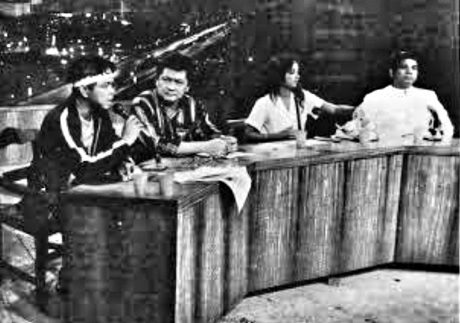
Assistant Secretary for Social Media Mocha Uson actually does raise scrumptuous food for thought in her two recent “surveys” regarding the 1986 EDSA “People Power Revolution”. Uson presumably uses today’s loose definition of “fake news” being bandied around by, in all ironies, the Liberal Party leaders of the Opposition (a.k.a. the Yellowtards) and the Catholic Bishops’ Conference of the Philippines (CBCP), as a lens to take another look at what really happened back in 1986.
With the “fake news” angle in mind we could now look back and ask:
| SUPPORT INDEPENDENT SOCIAL COMMENTARY! Subscribe to our Substack community GRP Insider to receive by email our in-depth free weekly newsletter. Opt into a paid subscription and you'll get premium insider briefs and insights from us. Subscribe to our Substack newsletter, GRP Insider! Learn more |
By today’s standards, could the information disseminated by Opposition “activists” that triggered and moved Filipinos to mass on EDSA over several February days in 1986 be considered to be “fake news”?
Most Yellowtards slap the “fake news” label on pretty much any piece of information they arbitrarily regard as disagreeable to their personal sensibilities. They are also quick to latch on to whatever “authoritative” lists of “fake news sites” published by organisations they deem friendly to their “cause” like the CBCP and the National Union of Journalists of the Philippines (NUJP) among others. But, really, a more level-headed definition of “fake news” is already being widely-accepted by more level-headed observers and is encapsulated quite neatly by the Collins Dictionary:
false, often sensational , information disseminated under the guise of news reporting
In short, for information to be “fake news” it has to be information (1) deliberately disguised as a news report that is (2) published via a site or medium that deliberately pretends to be a news site and (3) deliberately aims to misinform the public. That definition pretty much discounts most blog sites, most social media posts, and most memes being propagated over the Internet. Beyond the space clearly delineated by this definition lies the free market of ideas where every participant is expected to take personal responsibility for their behaviour and what they consume.
One can argue that the radio and broadcast stations that directed “activist” actions then ceased to be true news media channels after they were taken over by rebel elements during the EDSA “revolt”. They had none of the editorial controls and processes that vetted information streaming in from the field and being concocted by presenters on the fly as they broadcast live. Most important of all, under rebel hands, these presumed “news” broadcasters became oriented towards a specific goal — which was to highlight information that would aid (1) defence of encamped mutineers in those EDSA military camps and (2) coordination of actions to overthrow the Philippine government at the time led by then President Ferdinand Marcos.
Thus, the folks who ran the broadcast facilities seized by rebels during the EDSA “revolution” behaved more like mass action directors and coordinators and less like events observers. True news reporting after all is most accurately described by the latter: observation of events and reporting these as observed, no more, no less.
It seems June Keithley, Maan Hontiveros, and the rest of the faces of the revolutionary “journalism” mob in those days were 1986’s equivalent of the infamous Rapplerettes of today. It was really unclear whether they were reporting the news or directing an “activist” movement.
Even more interesting, dissemination of “news” in those crucial several days leading to the “overthrow” of the Marcos regime was an effective monopoly. They operated under close oversight by the early Yellowtards and, more ominously, the Roman Catholic Church. Within those several days, Filipinos were effectively a captured audience and had no access to alternative points of view or guidance. The Rapplerettes in Mullets of those days had free rein to say anything to an audience who would readily lap it all up.
Did Radio Veritas and Radyo Bandido walk and quack like “fake news” sites at the time? Hindsight often becomes clear when viewed from the lens of modern-day ideas and notions. It’s hight time ordinary Filipinos (not their idols and celebrities) be the final judge of their own history.
benign0 is the Webmaster of GetRealPhilippines.com.
The Lopez owned ABS-CBN media , that was the propaganda machine of the Rebels , who were :EDSA mutineers. The Roman Catholic Church, was an active participant, because their agricultural lands: the Friars lands, were land reformed by the late Pres. Marcos, Sr. the Roman Catholic Chuch, is the defender of Feudal Oligarchy.
All in all the U.S. Ambassador to the Philippines, was under the order of the U.S. Dept. of State, to simulate a Peoples’ Uprising, and call it : People Power. The Rebels, used civilians as shields, to seek cover from the Marcos Loyalists. It was duplicated in China, during the reign of Chairman Deng Ziao Peng. It led to the , Tienamen Square massacre, in Beijing, China. The Chinese students were mercilessly massacred and some went into exile.
This was the U.S. fault…they thought they can do in China, what they had done in the Philippines.
So, the so called EDSA Peoples’ Power was Fake News, made by the disinformation department of the U.S./C.I.A., which was spread by the Aquino Cojuangco political axis propaganda machine. It is now Fake History, believed by dumb Filipinos.
It made: Cory Aquino, Cardinal Sin , Fidel Ramos, Juan Ponce Enrile, Gringo Honasan,
etc…heroes and patriots. In truth, they were tools of a foreign power to manipulate the political system of our country.
Words are Powerful Tools. Just one can destroy an entire Nation, so use them wisely.